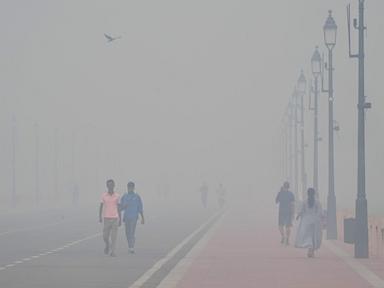World
New Delhi’s Air Quality Plummets After Diwali Fireworks

Thick smog enveloped New Delhi on October 25, 2023, following the Diwali celebrations that involved extensive fireworks displays. The use of firecrackers on the night of October 24 resulted in a significant spike in air pollution, pushing the city’s Air Quality Index (AQI) above 350 in various neighborhoods. This level is categorized as “severe” and poses serious health risks, according to the World Health Organization’s guidelines.
By Tuesday morning, the air was thick with smoke and fine particulate matter, combining with existing seasonal pollution and stagnant weather conditions. Visibility diminished across the capital, obscuring streets, buildings, and even historical landmarks. Tourists like Vedant Pachkande expressed their astonishment, stating, “I have never seen anything like this before. We can’t see anything here because of pollution.”
The Supreme Court of India had recently modified a previous ban on firecrackers during Diwali, permitting the use of “green firecrackers” that are designed to produce fewer pollutants. These environmentally friendly options, developed by federal research institutions, aim to reduce emissions by approximately 30%. The court allowed their use during specific hours from October 21 to October 24, but adherence to these regulations was lax, as has been the case in previous years.
New Delhi and its metropolitan area, home to over 30 million residents, consistently rank among the most polluted cities globally, particularly during winter months. The combination of Diwali festivities, cooler weather, and agricultural burning from nearby states exacerbates the air quality crisis.
In response to deteriorating air quality, local authorities have implemented measures such as restrictions on construction activities and limitations on diesel generator usage. Despite these efforts, environmental advocates argue that long-term solutions are necessary. They emphasize the need for cleaner energy sources and stricter vehicle emissions standards to effectively mitigate the recurring pollution crisis.
Further complicating matters, a recent study published in Scientific Reports revealed that increasing air pollution is reducing the amount of sunshine India receives. Researchers from Banaras Hindu University, including scientist Manoj K. Srivastava, found a steady decline in sunshine hours across most of India, attributing this trend to rising levels of aerosols from industrial emissions, biomass burning, and vehicle exhaust. Srivastava noted, “We see a greater impact in more polluted regions such as northern India,” highlighting that reduced sunlight could hinder solar energy generation and agricultural productivity, in addition to impacting public health.
As New Delhi grapples with the fallout from Diwali celebrations, the urgent need for comprehensive environmental policies becomes increasingly clear. Without significant changes, the capital’s air quality is likely to remain a pressing concern for its residents and visitors alike.
-

 Science4 weeks ago
Science4 weeks agoALMA Discovers Companion Orbiting Giant Red Star π 1 Gruis
-

 Top Stories2 months ago
Top Stories2 months agoNew ‘Star Trek: Voyager’ Game Demo Released, Players Test Limits
-

 Politics2 months ago
Politics2 months agoSEVENTEEN’s Mingyu Faces Backlash Over Alcohol Incident at Concert
-

 World2 months ago
World2 months agoGlobal Air Forces Ranked by Annual Defense Budgets in 2025
-

 World2 months ago
World2 months agoElectrification Challenges Demand Advanced Multiphysics Modeling
-

 World2 months ago
World2 months agoMass Production of F-35 Fighter Jet Drives Down Costs
-

 Business2 months ago
Business2 months agoGold Investment Surge: Top Mutual Funds and ETF Alternatives
-

 Science2 months ago
Science2 months agoTime Crystals Revolutionize Quantum Computing Potential
-

 Top Stories2 months ago
Top Stories2 months agoDirecTV to Launch AI-Driven Ads with User Likenesses in 2026
-

 Entertainment2 months ago
Entertainment2 months agoFreeport Art Gallery Transforms Waste into Creative Masterpieces
-

 Health2 months ago
Health2 months agoGavin Newsom Critiques Trump’s Health and National Guard Plans
-

 Business2 months ago
Business2 months agoUS Government Denies Coal Lease Bid, Impacting Industry Revival Efforts









